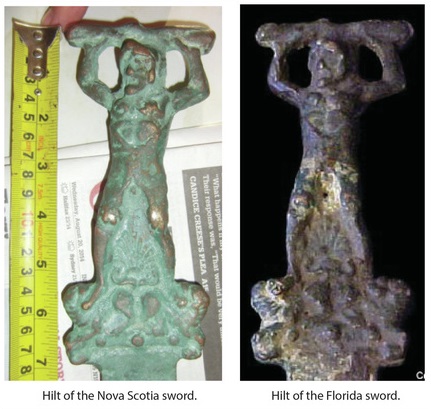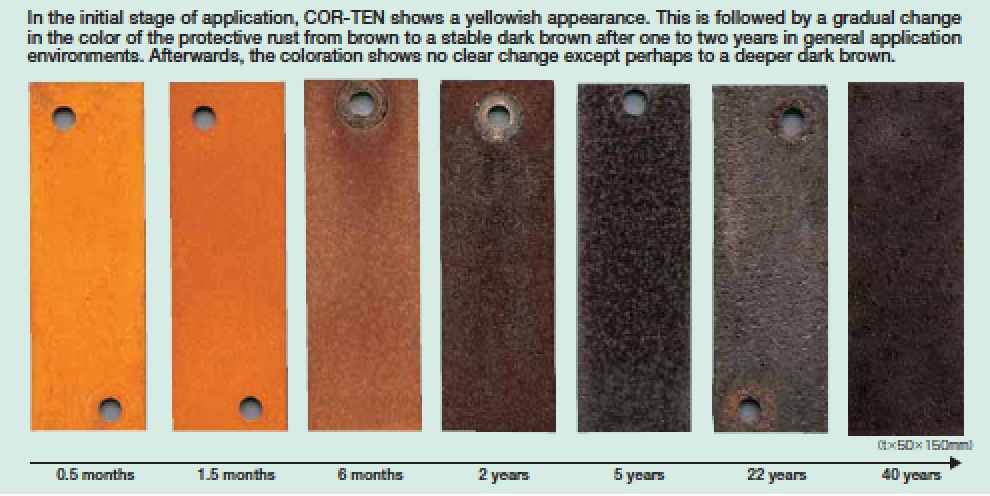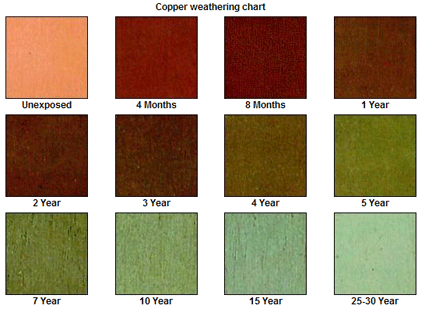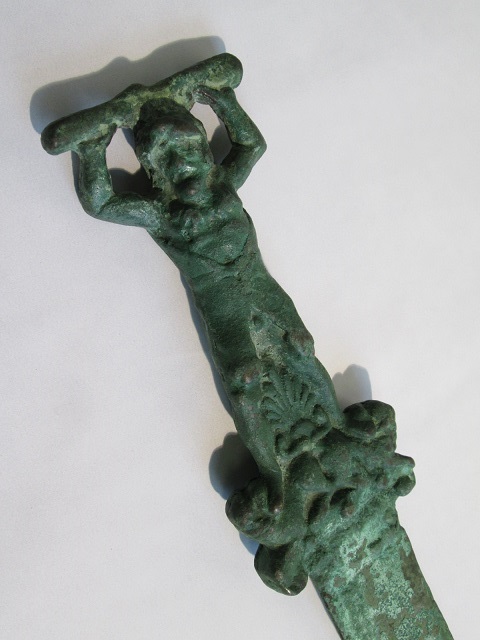It looks like you're using an Ad Blocker.
Please white-list or disable AboveTopSecret.com in your ad-blocking tool.
Thank you.
Some features of ATS will be disabled while you continue to use an ad-blocker.
share:
I'd like to draw all your attention to something Eisegesis posted earlier which it seems some of you might have missed
Its this photo

The sword on the right is a known genuine sword originating in Germany which is now in the hands of a known fraudster in Florida.
The sword on the left is the one they are claiming was found near oak island
Roman swords were made out of steel
This is a rust deterioration colour chart for rusting steel

As you can see the genuine sword is the same colour as the 40+ year rust chart says it should be
But the one which is being claimed for Oak island is green
Steel does not rust into a green colour
Only copper and copper alloys do that
Copper does not make effective swords being far too soft, the romans never made swords out of copper and as these swords are identical, you can safely assume that they should be made from the exact same material
This is a copper rust colour chart

So clearly, this new sword is a cheap copy of the genuine one and a recent copy at that. The owner of the original David Xavier Kenney, makes a living from selling antiquities and specialises in the Roman period. So all this proves is that David Kenny has been making copies of genuine swords and then selling them on artificially aged to the unsuspecting public.
Its this photo

The sword on the right is a known genuine sword originating in Germany which is now in the hands of a known fraudster in Florida.
The sword on the left is the one they are claiming was found near oak island
Roman swords were made out of steel
This is a rust deterioration colour chart for rusting steel

As you can see the genuine sword is the same colour as the 40+ year rust chart says it should be
But the one which is being claimed for Oak island is green
Steel does not rust into a green colour
Only copper and copper alloys do that
Copper does not make effective swords being far too soft, the romans never made swords out of copper and as these swords are identical, you can safely assume that they should be made from the exact same material
This is a copper rust colour chart

So clearly, this new sword is a cheap copy of the genuine one and a recent copy at that. The owner of the original David Xavier Kenney, makes a living from selling antiquities and specialises in the Roman period. So all this proves is that David Kenny has been making copies of genuine swords and then selling them on artificially aged to the unsuspecting public.
edit on 18-12-2015 by Marduk because: (no reason given)
a reply to: Marduk
I Agree. Any "Expert" would have no problem distinguishing that object from Iron. It is bronze.
Romans used bronze early on, but in the days of the empire, it was iron and steel. If it is actually authentic, then it would most likely be 1000 BC or earlier, which is a super stretch, but most likely faked, as you suggest.
I Agree. Any "Expert" would have no problem distinguishing that object from Iron. It is bronze.
Romans used bronze early on, but in the days of the empire, it was iron and steel. If it is actually authentic, then it would most likely be 1000 BC or earlier, which is a super stretch, but most likely faked, as you suggest.
originally posted by: charlyv
a reply to: Marduk
I Agree. Any "Expert" would have no problem distinguishing that object from Iron. It is bronze.
Romans used bronze early on, but in the days of the empire, it was iron and steel. If it is actually authentic, then it would most likely be 1000 BC or earlier, which is a super stretch, but most likely faked, as you suggest.
I'm thinking copper personally, this will be verified in a few days of course when Mr Pulitzer suffers a burglary with only one item taken the day before it goes off to the museum to be verified...
originally posted by: Marduk
This is a rust deterioration colour chart for rusting steel
As you can see the genuine sword is the same colour as the 40+ year rust chart says it should be
But the one which is being claimed for Oak island is green
Steel does not rust into a green colour
Only copper and copper alloys do that
Copper does not make effective swords being far too soft, the romans never made swords out of copper and as these swords are identical, you can safely assume that they should be made from the exact same material
This is a copper rust colour chart
So clearly, this new sword is a cheap copy of the genuine one and a recent copy at that. The owner of the original David Xavier Kenney, makes a living from selling antiquities and specialises in the Roman period. So all this proves is that David Kenny has been making copies of genuine swords and then selling them on artificially aged to the unsuspecting public.
Very useful chart! I noticed that it was some sort of bronze item - I think the work that you and the others have presented here really nails it as a modern hoax. Like you, I suspect that when it's "sent off to a museum to be identified" it will suddenly disappear with a lame excuse like it was take by the Illuminati to prevent us from learning our history or some such twaddle.
Im just surprised that anyone takes anything presented on the history channel seriously.
Bah!
Who needs dusty old color charts to help determine the provenance of this sword?
Silly Rabbit!
The optimal source for the provenance of ancient Roman swords is... Ebay!
SPECIAL COMMEMORATIVE SCULPTURE BRONZE SWORD HANDLE ROMAN STATUE EUR 75,00

Who needs dusty old color charts to help determine the provenance of this sword?
Silly Rabbit!
The optimal source for the provenance of ancient Roman swords is... Ebay!
SPECIAL COMMEMORATIVE SCULPTURE BRONZE SWORD HANDLE ROMAN STATUE EUR 75,00

edit on 18-12-2015 by oletimer because: nanananabooboo
edit on 18-12-2015 by oletimer because: na na na na boo boo
originally posted by: LABTECH767
a reply to: theantediluvian
Look's to have been a highly decorative item, I doubt it got there via the Roman's themselves but could have come via trade as a valuable item, maybe even early Nordic or even as many suspect Phoenician traders.
Still it is one of the most enigmatic sites in the US and who knows just maybe after all most of the documents that the Romans had were lost with the end of there empire and Columbus must have gained his claimed portolon's from somewhere if indeed he did have portolon's showing land to the west so maybe some roman expedition had reached that far it is conceivable though there ship's would have struggled in the Atlantic seas so the voyage would have been extremely treacherous, still they based them on Carthaginian vessels and there is claim the Carthaginians may have reached America over two thousand years ago so?.
Sorry, I'm gonna be THIS guy...and you're gonna be THAT guy.
Oak Island is NOT in the US. It is outside Halifax, NS, CANADA.
NOT THE UNITED STATES!
Carry on
originally posted by: oletimer
The optimal source for the provenance of ancient Roman swords is... Ebay!
SPECIAL COMMEMORATIVE SCULPTURE BRONZE SWORD HANDLE ROMAN STATUE EUR 75,00
I like the bit where it said "Vintage riproduzione "
exactly the same as the one in the OP
a reply to: LABTECH767
I am confused.
You said that Phoenician traders might have had a hand in delivering the item to its current location, but that would be odd, if only because my understanding of things is that the Phoenician culture had little influence after the fall of Rome, leave alone the power and spare resources to send a ship clear across an oceanic expanse which, at the time, was considered a route to the edge of the world.
They were a pre-Roman era culture, or at least, their culture influenced the Roman one, along with the Carthaginians, the Etruscans, and the various Greek cultures which came before the Romans. Where have I gone wrong?
I am confused.
You said that Phoenician traders might have had a hand in delivering the item to its current location, but that would be odd, if only because my understanding of things is that the Phoenician culture had little influence after the fall of Rome, leave alone the power and spare resources to send a ship clear across an oceanic expanse which, at the time, was considered a route to the edge of the world.
They were a pre-Roman era culture, or at least, their culture influenced the Roman one, along with the Carthaginians, the Etruscans, and the various Greek cultures which came before the Romans. Where have I gone wrong?
originally posted by: TrueBrit
a reply to: LABTECH767
I am confused.
You said that Phoenician traders might have had a hand in delivering the item to its current location, but that would be odd, if only because my understanding of things is that the Phoenician culture had little influence after the fall of Rome, leave alone the power and spare resources to send a ship clear across an oceanic expanse which, at the time, was considered a route to the edge of the world.
They were a pre-Roman era culture, or at least, their culture influenced the Roman one, along with the Carthaginians, the Etruscans, and the various Greek cultures which came before the Romans. Where have I gone wrong?
True, but a people who were Phoenician like and lived in southern Anatolia called the Cilicians were notorious pirates who put up a good fight against the Romans,so it's just barely possible they could have made the trip, not saying they did, but they could make a good alternative candidate.
edit on 18-12-2015 by Spider879 because: They did not occupy Northern Syria .
So I am confused. we always talk about other civilizations coming to the "New World" and it's always like something that is almost unbelievable. Is
there an assumption that Columbus was truly the first to come to the American continent?
Because I can't believe that a bit. I am pretty sure that throughout history many if not every civilization capable of certain technologies (like ships) were able to come over here.
The Norse were much earlier involved in American affairs than the Spaniards.
Humans can travel far in 20,000 years.
Because I can't believe that a bit. I am pretty sure that throughout history many if not every civilization capable of certain technologies (like ships) were able to come over here.
The Norse were much earlier involved in American affairs than the Spaniards.
Humans can travel far in 20,000 years.
I wouldn't trust J. Hutton Pulitzer aka J. Jovan Philyaw as far as I could throw him.
He sets off way too many alarm bells to me.....the show would have been better if he had never been on it.
1. The so called "Roman" sword is a replica of a known sword. The original is steel, the replica is copper.
2. So called "confirmed" roman ship wreck that is not even remotely confirmed.
3. Already putting out dis-info that it will be almost impossible to get permission to excavate the shipwreck, meaning it can never be proven.
4. Found shipwreck from memories of family member from an event that happened decades prior,,,, amazing how they could recall the exact spot so many years later.
Fake... bet money on it.
Edit: Another identical sword has turned up in California... that one was bought as a "replica" sword. So now there are at least 2 other identical swords. Fake Fake Fake.
He sets off way too many alarm bells to me.....the show would have been better if he had never been on it.
1. The so called "Roman" sword is a replica of a known sword. The original is steel, the replica is copper.
2. So called "confirmed" roman ship wreck that is not even remotely confirmed.
3. Already putting out dis-info that it will be almost impossible to get permission to excavate the shipwreck, meaning it can never be proven.
4. Found shipwreck from memories of family member from an event that happened decades prior,,,, amazing how they could recall the exact spot so many years later.
Fake... bet money on it.
Edit: Another identical sword has turned up in California... that one was bought as a "replica" sword. So now there are at least 2 other identical swords. Fake Fake Fake.
edit on R452015-12-18T10:45:50-06:00k4512Vam by RickinVa because: (no reason given)
a reply to: FamCore
Could it have been a Roman ceremonial sword looted by Vikings during the Germanic Iron age? Rome left a ton of relics through out Europe.
Also, the sword is copper as you can tell from the patine and roman's forged bronze weapons so not exactly sure what this is. Granted, this might have been explained but I'm doing a rapid glance and dash on this thread.
Could it have been a Roman ceremonial sword looted by Vikings during the Germanic Iron age? Rome left a ton of relics through out Europe.
Also, the sword is copper as you can tell from the patine and roman's forged bronze weapons so not exactly sure what this is. Granted, this might have been explained but I'm doing a rapid glance and dash on this thread.
a reply to: theantediluvian
Because skepticism is useful in validating or invalidating the truth..
In archeology physical context counts for a whole lot. We have a story of story of where this sword came from.
It does appear like a genuine artifact..Looks to be ceremonial and overly decorative compared to the vast majority of Roman Swords. It would have been a valuable item in it's day.
What they should be testing it for is the hallmarks of corrosion and crust (salinity?) that would tell them if this item is simply from someone's collection recently or a 100 years ago..or if it spent 100's of years in the ocean. From what I have seen in the past they can quickly determine if artifacts have spend long periods of time in the water.
Because skepticism is useful in validating or invalidating the truth..
In archeology physical context counts for a whole lot. We have a story of story of where this sword came from.
It does appear like a genuine artifact..Looks to be ceremonial and overly decorative compared to the vast majority of Roman Swords. It would have been a valuable item in it's day.
What they should be testing it for is the hallmarks of corrosion and crust (salinity?) that would tell them if this item is simply from someone's collection recently or a 100 years ago..or if it spent 100's of years in the ocean. From what I have seen in the past they can quickly determine if artifacts have spend long periods of time in the water.
originally posted by: oletimer
Bah!
Who needs dusty old color charts to help determine the provenance of this sword?
Silly Rabbit!
The optimal source for the provenance of ancient Roman swords is... Ebay!
SPECIAL COMMEMORATIVE SCULPTURE BRONZE SWORD HANDLE ROMAN STATUE EUR 75,00
Wow! Excellent research! I wish I could give you a bunch of stars for that find!
a reply to: Marduk
Awesome work. It sounds like either the brothers are a fraud...or the locals have figured out a way to make some cash from the silly TV Show people running around town
The one thing that confuses me is that according to your chart, if the fake is copper...it's patina does look relatively old? 15-30 years? So not a recent fake? Or do you think the huckster is mimicking an older patina?
And without leaning on patina charts...hand-crafted things like that sword varied in detail from one to the next. Even if the maker made 20 of those identical swords at the time...each one would be slightly different in appearance being hand-made vs. factory and mold copied...it looks like he copied the sword right down to facial features and exact proportions etc.
Awesome work. It sounds like either the brothers are a fraud...or the locals have figured out a way to make some cash from the silly TV Show people running around town
The one thing that confuses me is that according to your chart, if the fake is copper...it's patina does look relatively old? 15-30 years? So not a recent fake? Or do you think the huckster is mimicking an older patina?
And without leaning on patina charts...hand-crafted things like that sword varied in detail from one to the next. Even if the maker made 20 of those identical swords at the time...each one would be slightly different in appearance being hand-made vs. factory and mold copied...it looks like he copied the sword right down to facial features and exact proportions etc.
Will someone please explain to me. With all the money that has been spent on that island. Why haven't they just pit mined that whole section? I'm sure
the process wouldn't be easy with having to build a dam as well but with all the money that has changed hands in regards to that island and all the
money that will be spent. If Rick and Marty just did that from the start we would know what was down there at a much cheaper cost.
originally posted by: gflyg
Will someone please explain to me. With all the money that has been spent on that island. Why haven't they just pit mined that whole section? I'm sure the process wouldn't be easy with having to build a dam as well but with all the money that has changed hands in regards to that island and all the money that will be spent. If Rick and Marty just did that from the start we would know what was down there at a much cheaper cost.
I think there are restrictions as to how much they can dig, but I hope they come out and say the sword is fake to save any reputation they might have. Otherwise the whole show would turn into a sham for entertainment only.
You too can make history!!!!
Be the first to discover that romans visited Oak Island...........
All yours for the incredibly low low price of : 28.00
www.lnt.com... s&utm_medium=cpc&gclid=CjwKEAiA-s6zBRDWudDL2Iic4QQSJAA4Od3Xz1_PbDa4VBWDazaFBcLOtlQojAVPUdJilrFGZ2F7hhoChPHw_wcB

Pick yours up at Linen-n-Things today!!!
Be the first to discover that romans visited Oak Island...........
All yours for the incredibly low low price of : 28.00
www.lnt.com... s&utm_medium=cpc&gclid=CjwKEAiA-s6zBRDWudDL2Iic4QQSJAA4Od3Xz1_PbDa4VBWDazaFBcLOtlQojAVPUdJilrFGZ2F7hhoChPHw_wcB
Paying homage to the craftsmanship and technique of metal smiths in the Roman Empire, this exclusive museum replica is a rough iron foundry casting like those found in Pompeii. This remarkably heavyweight replica boasts characteristic details, and makes a handsome gift for yourself or anyone who enjoys Roman history or artifacts.

Pick yours up at Linen-n-Things today!!!
edit on R442015-12-18T11:44:16-06:00k4412Vam by RickinVa because: (no reason given)
edit on
R452015-12-18T11:45:08-06:00k4512Vam by RickinVa because: (no reason given)
new topics
-
Holy Cow! Erm...Six Legged Turkey!!
World Sports: 1 hours ago -
Ben Habib has Left Reform UK
Regional Politics: 5 hours ago -
Turkey Day Rhyme…
Short Stories: 5 hours ago -
Can someone please translate Biden's speech?
US Political Madness: 5 hours ago -
NIH Chief Confesses COVID Initiatives Were "Completely Made Up " OMG Investigates
Health & Wellness: 6 hours ago -
Awesome Dip Recipe
Food and Cooking: 9 hours ago -
Vladimir Putin's speech at the meeting of the CSTO Collective Security Council
World War Three: 9 hours ago
top topics
-
Happy Thanksgiving to ATS
General Chit Chat: 17 hours ago, 9 flags -
NIH Chief Confesses COVID Initiatives Were "Completely Made Up " OMG Investigates
Health & Wellness: 6 hours ago, 9 flags -
Vladimir Putin's speech at the meeting of the CSTO Collective Security Council
World War Three: 9 hours ago, 8 flags -
Can someone please translate Biden's speech?
US Political Madness: 5 hours ago, 7 flags -
Traveling the world with no passport
Social Issues and Civil Unrest: 14 hours ago, 6 flags -
Awesome Dip Recipe
Food and Cooking: 9 hours ago, 5 flags -
Turkey Day Rhyme…
Short Stories: 5 hours ago, 5 flags -
Ben Habib has Left Reform UK
Regional Politics: 5 hours ago, 4 flags -
Holy Cow! Erm...Six Legged Turkey!!
World Sports: 1 hours ago, 2 flags
active topics
-
Holy Cow! Erm...Six Legged Turkey!!
World Sports • 1 • : JJproductions -
NIH Chief Confesses COVID Initiatives Were "Completely Made Up " OMG Investigates
Health & Wellness • 11 • : Texastruth2 -
Awesome Dip Recipe
Food and Cooking • 5 • : JJproductions -
Vladimir Putin's speech at the meeting of the CSTO Collective Security Council
World War Three • 54 • : alldaylong -
Traveling the world with no passport
Social Issues and Civil Unrest • 8 • : annonentity -
Turkey Day Rhyme…
Short Stories • 4 • : JJproductions -
Mood Music Part VI
Music • 3721 • : BrucellaOrchitis -
V.P. Kamala Harris releases a video and nobody understands why
US Political Madness • 80 • : xuenchen -
Interesting Video-UFO?
Aliens and UFOs • 20 • : BrucellaOrchitis -
Happy Thanksgiving to ATS
General Chit Chat • 13 • : gort69
